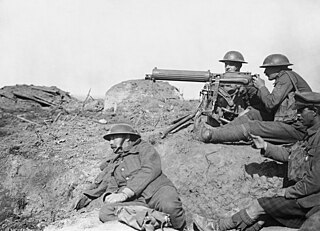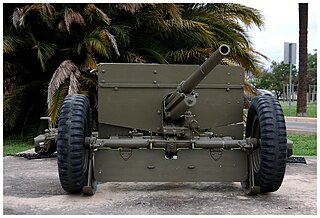
A Molotov cocktail, also known as a petrol bomb, bottle bomb, poor man's grenade, Molotovin koktaili (Finnish), polttopullo (Finnish), fire bomb or just Molotov, sometimes shortened as Molly, is a generic name used for a variety of bottle-based improvised incendiary weapons. Due to the relative ease of production, Molotov cocktails have been used by street criminals, protesters, rioters, criminal gangs, urban guerrillas, terrorists, hard-line militants, anarchists, irregular soldiers, or even regular soldiers short on equivalent military-issue weapons. They are primarily intended to ignite rather than obliterate targets.

The Projector, Infantry, Anti Tank (PIAT) Mk I was a British man-portable anti-tank weapon developed during the Second World War. The PIAT was designed in 1942 in response to the British Army's need for a more effective infantry anti-tank weapon and entered service in 1943.

Panzerschreck was the popular name for the Raketenpanzerbüchse 54, an 88 mm calibre reusable anti-tank rocket launcher developed by Nazi Germany in World War II. Another earlier, official common name was Ofenrohr.

Technology during World War I (1914–1918) reflected a trend toward industrialism and the application of mass-production methods to weapons and to the technology of warfare in general. This trend began at least fifty years prior to World War I during the American Civil War of 1861–1865, and continued through many smaller conflicts in which soldiers and strategists tested new weapons.

This article is about the weapons used in the Vietnam War, which involved the People's Army of Vietnam (PAVN) or North Vietnamese Army (NVA), National Liberation Front for South Vietnam (NLF) or Viet Cong (VC), and the armed forces of the Army of the Republic of Vietnam (ARVN), United States, Republic of Korea, Philippines, Thailand, and the Australian, New Zealand defence forces, and a variety of irregular troops.

The grenade, hand, anti-tank, No. 75, also known as the "Hawkins grenade" was a British anti-tank hand grenade used during World War II. It was one of a number of grenades developed for use by the British Army and Home Guard in the aftermath of the Dunkirk evacuation. The grenade first appeared in 1942, and was designed to be more versatile than previous grenades, such as the No. 73 grenade and the sticky bomb.

The Type 89 Grenade Discharger, inaccurately and colloquially known as a knee mortar by Allied forces, is a Japanese grenade launcher or light mortar that was widely used in the Pacific Ocean theatre of World War II.

The Panzerbüchse 39, abbreviated PzB 39, was a German anti-tank rifle used in World War II. It was an improvement of the Panzerbüchse 38 rifle.

The Projector, 2.5 inch—more commonly known as the Northover Projector—was an ad hoc anti-tank weapon used by the British Army and Home Guard during the Second World War.

The 37 mm Gun M3 is the first dedicated anti-tank gun fielded by United States forces in numbers. Introduced in 1940, it became the standard anti-tank gun of the U.S. infantry with its size enabling it to be pulled by a jeep. However, the continuing improvement of German tanks quickly rendered the 37 mm ineffective and, by 1943, it was being gradually replaced in the European and Mediterranean theaters by the more powerful British-developed 57 mm Gun M1. In the Pacific, where the Japanese tank threat was less significant, the M3 remained in service until the end of the war.

The M2 Mortar is a 60 millimeter smoothbore, muzzle-loading, high-angle-of-fire weapon used by U.S. forces in World War II, the Korean War, and the Vietnam War for light infantry support.

The Brandt mle 27/31 mortar was a regulation weapon of the French army during the Second World War. Designed by Edgar Brandt, it was a refinement of the Stokes mortar. The Brandt mortar was highly influential, being licensed built or copied by numerous countries.

The 4th Parachute Division,, was a divisional-sized elite formation in the Luftwaffe during World War II.

The M9 rifle grenade was a U S anti-tank rifle grenade used during World War II. It was derived as a lighter version of the M10 grenade which was too heavy to be fired to an effective distance from a rifle.

The Gewehr-Granatpatrone 40 or GGP/40 for short was a shaped charge rifle grenade used by German forces during the Second World War. It was originally developed for Luftwaffe Fallschirmjäger units to provide them with a light and portable anti-tank weapon.



























